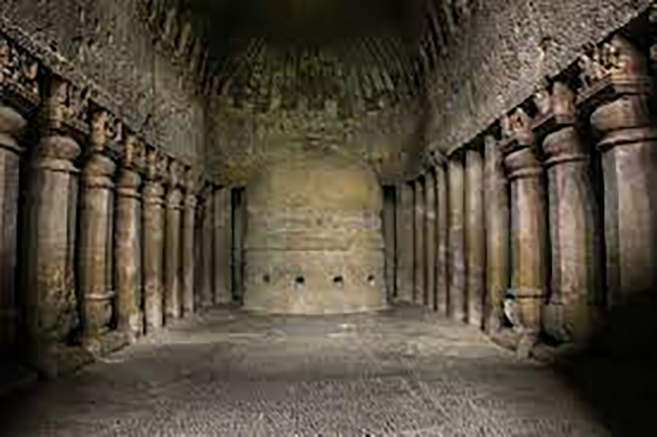Kanheri Caves | 20 May 2022
For Prelims: Kanheri Caves, Buddhism, Vajrayana, Satavahana, Hinayana and Mahayana
For Mains: Significance of the Buddhist architecture
Why in News?
Recently, the Ministry of Tourism has inaugurated the amenities in Kanheri Caves on the occasion of Buddha Purnima.
What are the kanheri Caves?
- About:
- The Kanheri Caves are a group of caves and rock-cut monuments located on the western outskirts of Mumbai. The caves are located within the forests of the Sanjay Gandhi National Park.
- The name Kanheri is derived from ‘Kanhagiri’ in Prakrit and occurs in the Nasik inscription of the Satavahana ruler Vasisthiputra Pulumavi.
- Kanheri was mentioned in the travelogues of foreign travellers.
- The earliest reference of Kanheri is ascribed to Fa-Hein who visited India during 399-411 CE and later by several other travellers.
- Excavations:
- The Kanheri caves comprise more than 110 different rock-cut monolithic excavations and is one of the largest single excavations in the country.
- The scale and extent of excavations, with its numerous water cisterns, epigraphs, one of the oldest dams, a stupa burial gallery and excellent rainwater harvesting system, indicate its popularity as a monastic and pilgrim centre.
- Architecture:
- These excavations were primarily undertaken during the Hinayana phase of Buddhism but also has several examples of the Mahayana stylistic architecture as well as few printings of the Vajrayana order.
- Patronage:
- Kanheri flourished under the patronage of Satavahana, Traikutakas, Vakatakas and Silaharas and through donations made by the wealthy merchants of the region.
- Significance:
- Kanheri caves are part of our ancient heritage as they provide evidence of evolution and our past.
- The architectural and engineering marvel of heritage sites like Kanheri caves or the Ajanta Ellora caves signify the knowledge about art, engineering, management construction, patience and perseverance that people had back then.
- Many such monuments back then took more than 100 years to be built.
- Its importance is heightened by the fact that it is the only centre where a continuous progression of Buddhist faith and architecture is observed as an unbroken legacy right from 2nd century CE to 9th century CE is observed here.
What is Hinayana and Mahayana?
- Hinayan:
- Literally Lesser vehicle, also known as Abandoned Vehicle or Defective vehicle. It believes in the original teaching of Buddha or Doctrine of elders.
- It does not believe in Idol worship and tries to attain individual salvation through self discipline and meditation.
- Theravada is a part of Hinayana sect.
- Mahayana:
- This sect of Buddhism believes in the heavenliness of Buddha and believes in Idol Worship.
- It originated in northern India and Kashmir and then spread east into Central Asia, East Asia and some areas of Southeast Asia.
- Mahayana believes in Mantras.
- Its main principles were based on the possibility of universal liberation from suffering for all beings. That's why, this sect is called Mahayana (The Great Vehicle).
- Its principles are also based on the existence of Buddhas and Bodhisattvas embodying Buddha nature. It allows salvation through having faith and committing oneself to Buddha.
UPSC Civil Services Examination, Previous Year Questions
Q. With reference to the religious history of India, consider the following statements: (2016)
- The concept of Bodhisattva is central to Hinayana sect of Buddhism.
- Bodhisattva is a compassionate one on his way to enlightenment
- Bodhisattva delays achieving his own salvation to help all sentient beings on their path to it.
Which of the statements given above is/are correct?
(a) 1 only
(b) 2 and 3 only
(c) 2 only
(d) 1, 2 and 3
Ans: (b)
Exp:
- The term Bodhisattva is literally a living being (Sattva) who aspires to enlightenment (Bodhi) and carries out altruistic practices.
- Bodhisattva ideal is central to the Mahayana Buddhist tradition and is portrayed as the individual who seeks enlightenment both for him or herself and for others. Hence, statement 1 is not correct and statement 3 is correct.
- Compassion, an empathetic sharing of the sufferings of others, is the Bodhisattva’s greatest characteristic. Hence, statement 2 is correct.

